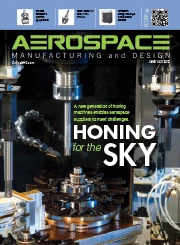 The staff of Aerospace Manufacturing and Design, Today's Medical Developments, Today's Energy Solutions, and American Manufacturing announces the highlights of their hands-on, user friendly, interactive booth. Booth W-100 will highlight the iPad and Droid versions of American Manufacturing, displaying the magazine’s interactive capabilities on a large touchscreen as well as various iPad stands.
The staff of Aerospace Manufacturing and Design, Today's Medical Developments, Today's Energy Solutions, and American Manufacturing announces the highlights of their hands-on, user friendly, interactive booth. Booth W-100 will highlight the iPad and Droid versions of American Manufacturing, displaying the magazine’s interactive capabilities on a large touchscreen as well as various iPad stands.
Booth W-100 will also be the place for a close-up look at the Buckeye Bullet; The Ohio State University’s all electric vehicle that recently reached a top speed of more than 320mph. Next, take the opportunity to look and feel the inner working of the human body with a synthetic body from SynDaver. Then move on to view several Unmanned Air Vehicles from Oklahoma State University, and Lockheed Martin's K-Max helicopter before having the opportunity to have you photo taken with Flyer 1, the experimental aircraft created by the Wright brothers in 1903. Finally take time to pilot Flyer 1 via a simulator.
Whether you are experiencing history with Flyer 1 or the future of aviation with the UAVs, learning more about the human body or viewing electric cars, make sure to have your badge scanned at booth W-100 for a chance to win an iPad 3, with one winner chosen Monday – Friday.
 Covering more than a century of aviation
Covering more than a century of aviation
Since its inception more than 110 years ago, aviation has constantly been evolving. The materials the Wright brothers initially used on Flyer 1 were from a giant spruce. In the 1920s that quickly changed into aluminum, then to a form of composites (fiberglass) in the 1950s, and today, it is the use of CRP (carbon reinforced fibers). As materials change, so does everything else. The future of aviation are UAVs (unmanned air vehicles), which can be controlled via remote (e.g. flown by a pilot at a ground control station) or can fly autonomously based on pre-programmed flight plans or more complex dynamic automation systems. Some UAVs, such as the K-Max, have the capability to fly via a remote or in a traditional manner with an onboard pilot.
 Speeding toward the Future
Speeding toward the Future
 Imitation, truly the sincerest form of flaterry
Imitation, truly the sincerest form of flaterry
Manufacturing the world's most sophisticated synthetic human tissues and body parts, SynDaver's synthetic human bleeds, breathes, and employs hundreds of muscles, bones, organs, and vessels. Design and make-up of the body is from materials that mimic the mechanical, thermal, and physico-chemical properties of live tissue. Use of this validated technology is to replace live animals, cadavers, and human patients in medical device studies, clinical training, and surgical simulation.

Explore the June July 2012 Issue
Check out more from this issue and find your next story to read.
Latest from Aerospace Manufacturing and Design
- AAMI project call submission deadline extended to May 12
- Jergens launches cast iron tooling column additions
- Airbus to acquire assets relating to its aircraft production from Spirit AeroSystems
- FANUC America's Cobot and Go web tool
- Chicago Innovation Days 2025: Shaping the future of manufacturing
- High-density DC/DC converters for mission-critical applications
- #59 - Manufacturing Matters: Additive manufacturing trends, innovations
- ACE at 150: A legacy of innovation and industry leadership





